By Yvonne Wright • The Current Contributing Writer
It is not frequent that we encounter an exceptionally creative person, whose naturally bestowed gifts of intellectual and artistic perception are also combined with an intrinsic restlessness and perpetually inquiring mind. Such desirable characteristics are often found in highly innovative individuals destined for success, or those whose significant life accomplishments may at times provide an impetus for heated misunderstanding in others, even resentment. Destiny chooses artists to provide cultural contributions often only granted full appreciation through the passing of time; recognized by the works they leave behind, within the communities they serve.
Life with an artist isn’t easy, but those who have made a long-time commitment to such persons are art history’s behind-the-scenes great contributors. Long-suffering, it is often the artists’ partners who, although remaining in the shadows of their brightly shining stars, often provide a nourishing environment and support base necessary for creative individuals to thrive in and produce. Sometimes capricious or moody, and unceasingly intense, an artist’s relationship with the ‘outside world’ can be tumultuous; particularly, if by the grace of a smiling fortune, a successful artist proves himself/herself not only talented but visionary.
Frank Lloyd Wright designed some of the most innovative buildings of 20th Century America, but as an unabashed genius, he often drove his generous patrons to the depths of despair with constant demands and requests, unwilling to compromise an inch. His entire life was a study in extremes, and yet, six decades after his passing, we come to agree with most of his high ideals.
The picturesque town of Jim Thorpe has its own share of talented artists who have made their base within its beautifully Victorian neighborhoods – adding to the town’s allure with their broad range of artworks. However, none of the artists currently living and/or working in Jim Thorpe can be considered more familiar to the general community, artistically identifiable, admired and disputed, frequently controversial, unique and outspoken than Victor Stabin. Tall and imposing, the artist is a highly accomplished creative guru from New York City – a painter, graphic designer and multimedia animator who ‘left his heart in Manhattan,’ but tried to bring the essence of its spirit to Jim Thorpe by creating the much admired today Stabin Museum & Cafe Arielle, a 16,000 square foot art/entertainment complex in Jim Thorpe’s west end at 268 West Broadway – with its newest addition, Vic’s Jazz Loft, an intimate performance venue “attracting some of the highest caliber artists on the planet.” The Washington Post once described the building complex as, “beautifully rebuilt and completely contemporary, it feels urban enough to be in New York or London.” An ideal setting for promoting a variety of cultural disciplines, from art and music to education and communication, alongside a taste for gourmet foods, all presented lovingly and professionally for discerning tastes in the greater Carbon County area and beyond.
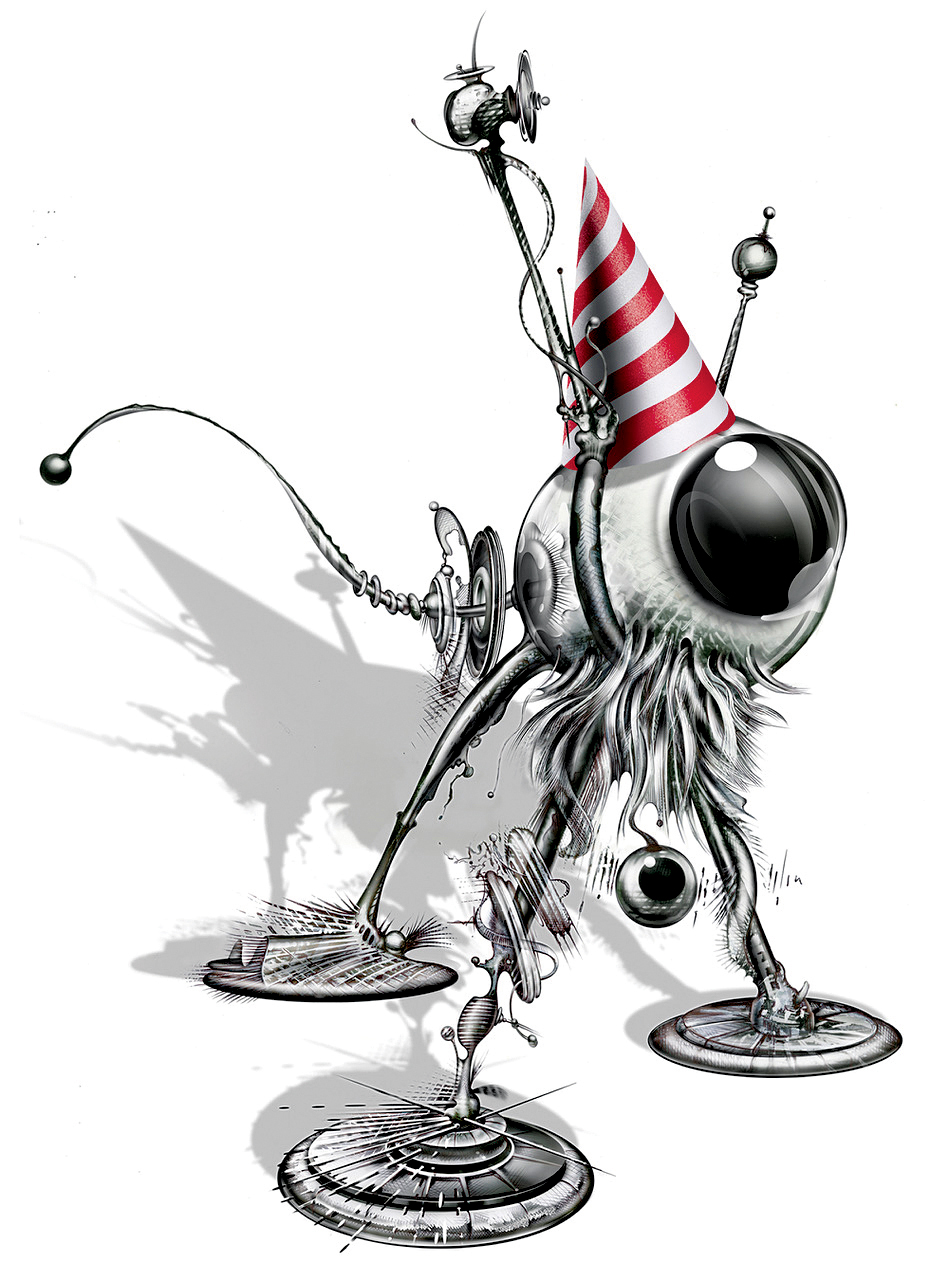
Work intuitively reflects Victor’s admiration for his father’s abilities in mechanical engineering
What motivated you to buy an old industrial relic, and to renovate it into the fabulous art and entertainment complex it is today? I asked Victor Stabin. “Artists need old buildings” responded the artist. “I let too many pieces of Manhattan float by, thinking there would always be time to get something. When [this] building came up for sale, I just had to have it. 268 is irreplaceable” and a vision eighteen years in the making. “The building unfolded like a never-ending dream” continued Victor proudly, “Joan wanted to have a restaurant; I wanted studio and a gallery space. We turned a dilapidated hulk into a gem.” So they did, indeed.
Victor Stabin’s family history, as well as his own early career-paths prepared him for an adventurous life, making him a flamboyant, risk taking visionary. It all started in 1910 at the mouth of the Hudson River, when a ten-year-old girl (Victor Stabin’s future maternal grandmother) stepped off the ship from Kyiv at the Ellis Island immigration station to join other newly arriving immigrants from Europe at the check point. Little did she know that one day she would marry an East-European emigrant from Odessa, who also arrived in the United States via Ellis Island. As did another young girl crossing the gates of Ellis, Victor’s paternal grandmother, arriving in America from Poland with her family. It has been estimated that close to 40 percent of all current U.S. citizens can trace at least one of their ancestors to Ellis Island, escaping from political and economic hardships in Europe; all arriving with hopes and dreams for greater opportunities in the New World. Many immigrants remained in New York, while others traveled by railroad to their new destinations across the country.
“My childhood was magical,” reminiscences Victor with fondness, “I was born in Manhattan and spent the first eight years of my life in Brooklyn. My dad was funny, smart, and a great storyteller.” Jacob V. Stabinsky (later Jack V. Stabin) was also a brilliant scientist trained at Yale and Columbia, who made scientific instrumentation needed for the Manhattan Project, and who, according to the US Army (which he joined at the age of 19), had “the highest mechanical aptitude on the Eastern Seaboard;” talents he employed at Oak Ridge, Tennessee (aka the ‘Secret City’) – a settlement built in 1942 by the US government to serve as a home base to Manhattan Project employees, while World War Two raged.
“After the war, my dad went into business for himself as J. V. Stabin Instruments” recalls Victor “inventing and designing scientific instrumentation for international research and development entities such as DuPont, Hewlett Packard, the Massachusetts Institute of Technology (MIT), and the Defense Advanced Research Project Agency (DARPA). “He was in his own world” continues Victor affectionally, “he would draw gear trains on napkins while watching TV, and was able to combine multiple disciplines with the ease of a genius (from laboratory glass blowing to ultra high-end machinist manufacturing). My father was mystically talented” proclaims the artist proudly, and yet, “he couldn’t figure out why I wanted to be an artist, and simply reconciled with the inevitable.”
Victor’s mother, on the other hand, quickly recognized her son’s budding talents, and when he was 11 she arranged for private art lessons with Mrs. Dalsky, an “eccentric middle aged Eastern European woman with a thick accent, who on weekends turned the living room in her small apartment into an art studio by throwing linen sheets over all the furniture.” The beautifully stylish Florence Stabin was a gifted pianist, who began studying classical piano at the age of eight. She loved performing Beethoven, Chopin and Rachmaninoff, and taught piano for 75 years. She smoked until she was 76, and lived to be 91. Florence was an avid supporter of art education, and ensured that her son Victor attended art classes throughout his youth. She was also, as Victor tenderly remembers her, “an overly opinionated, culturally urbane character who referenced world history by periods in classical music.” Her sister Penny was a model. After moving to Jim Thorpe in 2016, Florence enjoyed weekly Scrabble Court meetings at her place, and the company of family and friends.
Once exposed to the basic arcana of art, Victor’s hunger to learn and explore only grew. At thirteen, he spent summer months taking life drawing classes at the country’s oldest independent art school, the Art Students League of New York, notorious for attracting prominent international celebrities to teach there. An art experience followed by three years at the High School of Art & Design, whose mission has always been to inspire, educate and fully prepare gifted students to become exceptional artists like Victor, who majored in illustration.
After graduation, the possibilities to learn different approaches to art and artistic philosophies opened up even wider, and Victor’s restless spirit took him across the continent, first to Hollywood, California, to study illustration at the Art Center College of Design (today in Pasadena), and then back to New York for a couple of semesters at the School of Visual Arts in Manhattan where Victor first met his lifelong mentor and a brilliantly versatile American illustrator, painter and a storyteller Marshall Arisman (1938-2022), an artist who famously once said that “the fine art world stigmatizes people for illustrating […] Every gallery tells me to quit illustration.”
Arisman’s influence on Victor must have been considerable, because the artist never abandoned his love of illustration – on the contrary, he made it his vocation. Through the use of various mediums and aesthetic narratives (from traditional drawings and paintings, to digital animation), over the years Victor’s polished craftsmanship has enabled the artist to arrive at that unique and easily recognizable but difficult to replicate, ‘Stabin-style’ that makes him stand out in the highly competitive world of art and demand attention.
A long list of accomplishments serve as evidence of Victor’s versatility and talent: many illustrations done for high profile magazines like Rolling Stone, Time, Newsweek, Heavy Metal, and The New York Times; his album cover for the rock band KISS is one of their best; and there is that fabulous large mural for the RCA Records Corporate Headquarters. A clothing manufacturer once employed Victor to create several artworks for their shirts, a job that took the artist to Hong Kong for a month, and Mick Jagger once wore a shirt bearing one of Victor’s designs at a Rolling Stones concert on Staten Island. He contributed designs for a successful advertising campaign for the Cunard Line (Britain’s high-end cruise line known for luxury and its links to royalty); and most recently, four of Victor’s artworks got installed at the WNYC radio station. Impressively, his ABC Book Daedal Doodle is currently available for sale at the Metropolitan Museum of Art (The Met) in New York City.
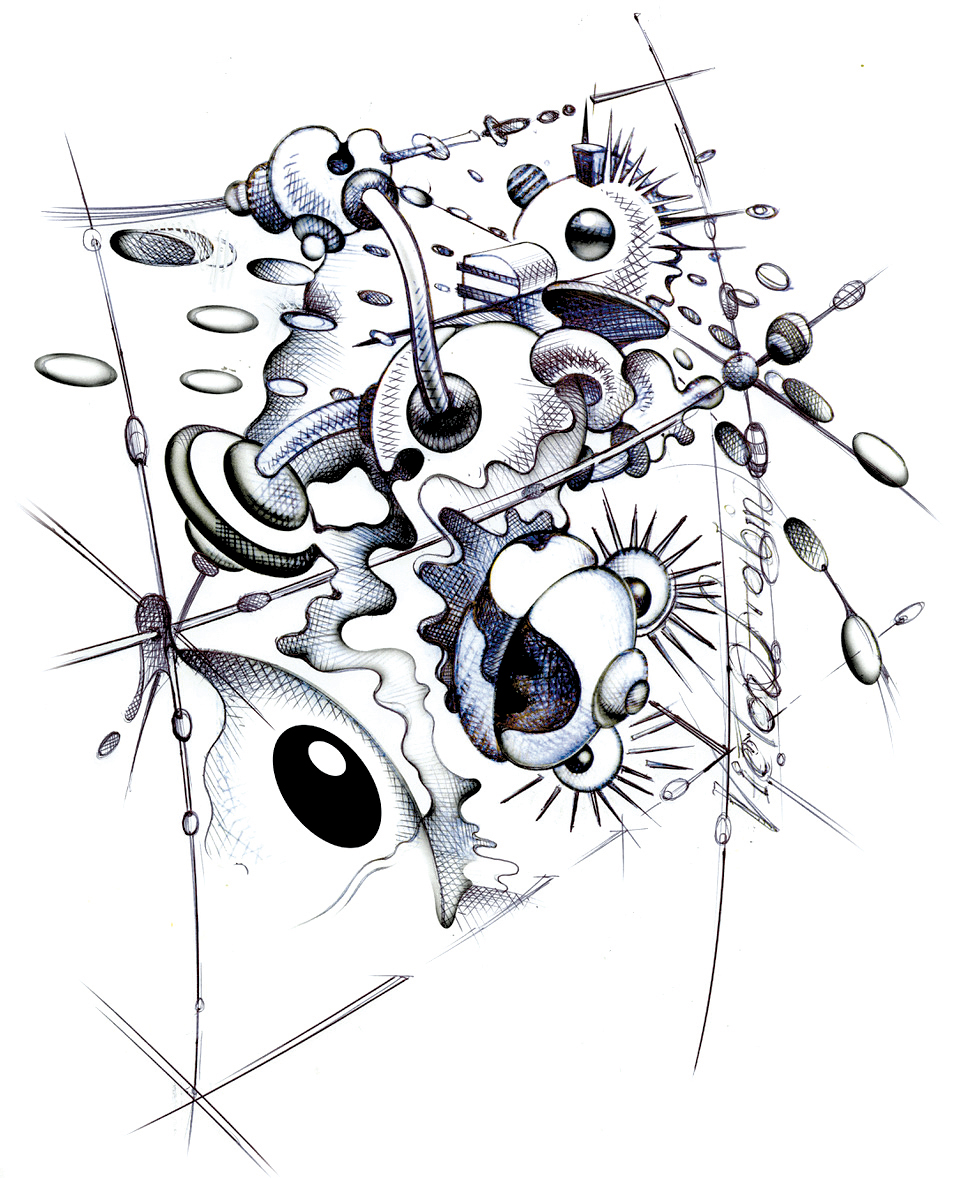
A 3” x 5” ballpoint pen drawing
Creative destiny had it in for Victor, because the day after he decided that he “would never do another [commissioned] illustration again,” the artist received a call from the US Postal Service that led to a commission of nine stamp-designs. “The first stamp I designed (of Henry Mancini) was initially assigned to one of the world’s most notable illustrators” explains Victor, “his concept was rejected and they loved my idea. After that, they gave me another eight to do, celebrating US Scientists.” The unveiling of the new stamp collection was held at the Walt Disney Concert Hall in Los Angeles, one of the most spectacularly creative examples of contemporary architecture in North America, designed by Canadian architect Frank Ghery. During the presentation, Senator John Glenn graciously praised Victor’s stamp designs and asked him to stand up and take a bow in front of a large prestigious audience; a truly crowning moment for an already accomplished artist.
Frighteningly, in 1999 at the age of forty six, the ever-busy influencer had to slow down and seriously refocus on his personal life and artistic future… Victor was diagnosed with non-Hodgkin’s Lymphoma. “I got cancer and received heavy-duty chemo for two years” shared Victor with a sigh. Fortunately for the art world today, the artist “got on the other side,” and after recovery decided never to do another freelance-based illustration again but rather, to concentrate on the works that matter to him personally and without compromises. “The difference between fine art and illustration is that an illustration assignment begins with a phone call. I no longer had the luxury of time, nor the desire to wait for that call” confesses the artist. Today, Victor lives cancer-free in Jim Thorpe, but the reminder of life’s frailties has only refined his talent and sharpened his eye for life’s priorities that began in his childhood…. being fully immersed in creativity that mattered.
What is the story behind the great Turtle Series? I asked. “Thank you for noticing” responded Victor cordially, “as an illustrator, I always found the time to do personal work. I did a painting series of people and animals walking on water. The On Water series turned into the Turtle Series as a self-imposed assignment. If I was going to sell myself as a painter, I needed a thematic body of work. I chose turtles, because of two paintings that inspired it: Marshall Arisman’s Light Runners (ca. 1990s) and Rene Magritte’s The Secret Garden (1927). Coincidentally, my first boyhood pet was a tiny, coin-size baby turtle.”
In many cultures, sea turtles have a broad multicultural and mythological resonance, to which many artists are drawn intuitively. They often symbolize patience, wisdom, endurance, and good luck. One year, when Victor visited his friends in the Caribbean, he went snorkeling in the deep sea. Forewarned but hopeful, he encountered a large, slow-moving sea turtle, which he naturally attempted to catch. “She allowed me to get as close as a couple of inches away, but never touch” remembers Victor with amusement. “We swam together for half an hour, and then she rapidly vanished off into a distant depth. Alone, I found myself awed by her playful intelligence, humbled by her dominance of the environment, hypnotized by her graceful moves, dazzled by her beauty and stunned by my ignorance.”
Working on the painting series quickly changed from an assignment to passion and the stories Victor has been incorporating into the panels are autobiographical in nature and allegorical of his family. It seems natural to the artist to paint his family in the context of these iconic sea creatures (e.g., Patron Saint of Perpetual Vision). “I have four more Turtle Series paintings in my head” Victor promises. “After they’re executed, I want to make them into a book. I feel, these paintings give me immortality, when my children will pass [them] onto their children” reveals Victor somewhat sheepishly “these paintings are my stories; the more of this work I do, the longer I live.”
Following the birth of his children, Skyler and Arielle, reading of “too many mind-numbing ABC books” prompted the artist into creating the first three pages of Daedal Doodle, his dictionary-inspired ABC book. “So many concepts raced through my head while reading the dictionary that I had to make the whole book” explains the artist. “The process of using dictionary to make a book has become a legit multidiscipline curriculum for me. When characters in the book needed stories, I began to write.”
Although originally conceived of as a book, Daedal Doodle series of drawings are also beautifully reproduced and elegantly framed individual works of art, today displayed at the Stabin Museum in Jim Thorpe, where they can be purchased. Since their conception, the series has attracted the critical attention of many promoters. A one-man show at the Allentown Art Museum inspired several invitations from local high schools, and Victor became a guest-speaking artist promoting the power of dictionary through his art. There were also multiple educational grants from the Pennsylvania Council of the Arts, with co-funding support from the NEA. Additionally the artist was invited to lecture at the Metropolitan Museum of Art in New York, followed by an NPR Radio interview.
Because “the [Daedal Doodle] stories needed animation,” explains Victor, “I created an animated short film E=MC3, which has been presented at fourteen international film festivals, receiving four Best Animation awards. Past all that, I am constantly doodling to the point of worry [he laughs], but I think they are enormous fun. I’ve been developing a technique for enlarging my ballpoint pen drawings from 3” x 5” index cards to 4 x 6 ft. prints for the most visual and aesthetic impact” (e.g. Ducky Doggy Doodle).
Where do you see yourself in five years? I asked. “Finish 268 West Broadway” Victor answered without hesitation, and then “market Daedal Doodle globally, as it is already establishing itself nationally as a creative platform involving education, animation, and book sales. I also plan to finish the Turtle Series of paintings, and make them into a book. The originals will be displayed at the Stabin Museum, or sold through galleries outside Jim Thorpe. I also want to create a new series of paintings, and integrate my doodle style into everything I do, maybe even create a new book titled “Conversations” with no words, only doodle drawings. I hope to get my Daedal Doodle books into the gift shop at the Museum of Modern Art (MoMA) in Manhattan, and most importantly… to sell my painting “Pearls Before Slime” for $1,000,000… After that, see you on the Red Carpet!”
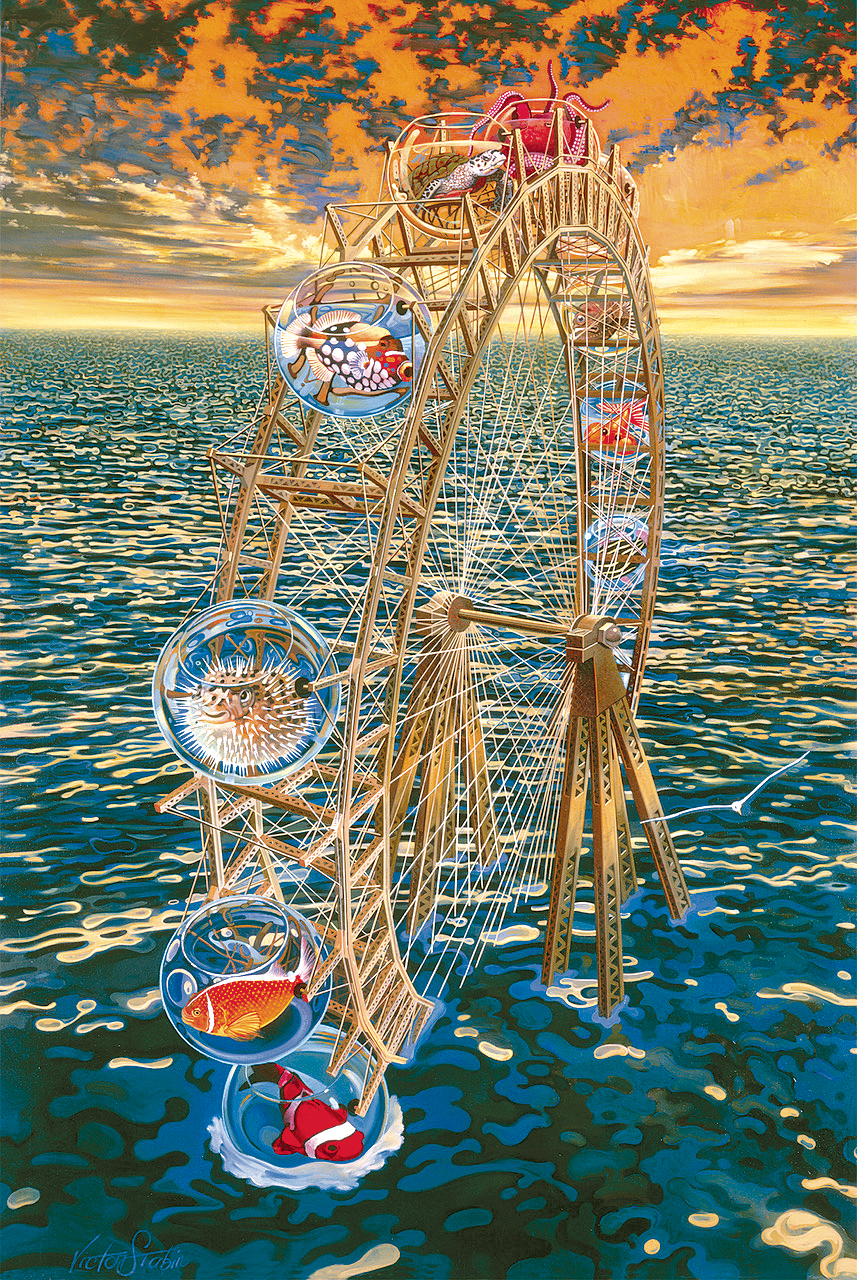
Oil on canvas
Some say that artists are made, not born, and the arguments on both sides are persistently fierce. However, there is no denying that the home environment in which young people grow up can influence, and even stimulate their future professional choices. It is especially noted in artistically inclined children, who are raised in a creatively rich environment, in families with artistic pedigrees. The Stabin family is a great example. Both of Victor’s daughters are highly creative, skillful, and imaginative – characteristics which enabled them to win local awards, and most recently, significant academic scholarships.
Skyler Stabin, who has been playing piano since the age of six, and currently studies piano and music business at the College of Saint Rose in Albany, New York, gave a sellout performance at the Stabin Museum while still in high-school, inadvertently inspiring the creation of Vic’s Jazz Loft (a newly renovated space for live music performances at 268 West Broadway). An accomplished pianist herself, Florence Stabin once proclaimed that in her seventy-five years of teaching piano, she had never had a student who could read music faster than Skyler.
Another talented young artist in the family is Arielle Stabin, whose hopes are to be a successful illustrator and a graphic novel creator. She will be attending the prestigious School of Visual Arts in New York next year, following the family tradition as it is one of Victor’s old stomping grounds. But grandma Florence already knew that Arielle was brilliant, and playfully teased that she is “a much better artist than her dad…” to Victor’s proud delight!
Undeniably, Victor Stabin is an exceptionally creative person, who, as an expatriated New Yorker living in Jim Thorpe, has brought with him larger than life plans and ideas, some of which at the time of their realization (the dramatic transformation of the old wireworks factory and the former Silk Mill into the 268 West Broadway arts-complex) seem to thunderbolt the unsuspecting neighborhood out of their nostalgic quietness and comfort. Perpetually creative, unapologetically frank but sincere, the artist talks big and puts his efforts where his mouth is by envisioning possible improvements this beautiful town could benefit from. Victor’s dream is for our town to become more inclusive, tourist friendly, and hopefully one day America’s most wonderful place to live.
In that respect, he is not alone. There is a growing number of new visionary mavericks whose plans regarding Jim Thorpe are worthy of its illustrious history. Some exciting ideas are already being evaluated at the highest local levels. This new generation of businesspeople, like Victor and his wife Joan Morykin, fell in love with a town of great possibilities, and wish to contribute to its ongoing prosperity; first in beating the post-Pandemic recession, and then in securing a stable economic base for the whole community to benefit from (e.g., through local job opportunities). There is also a growing need to recognize the fact that the many facets of culture in the framework of tourism is the cornerstone of many small-town’s hopes for a sustainable future.
Yvonne Wright is the owner of STUDIO YNW at 100 West Broadway in Jim Thorpe. She can be reached at studio.ynw@gmail.com





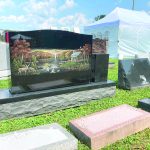


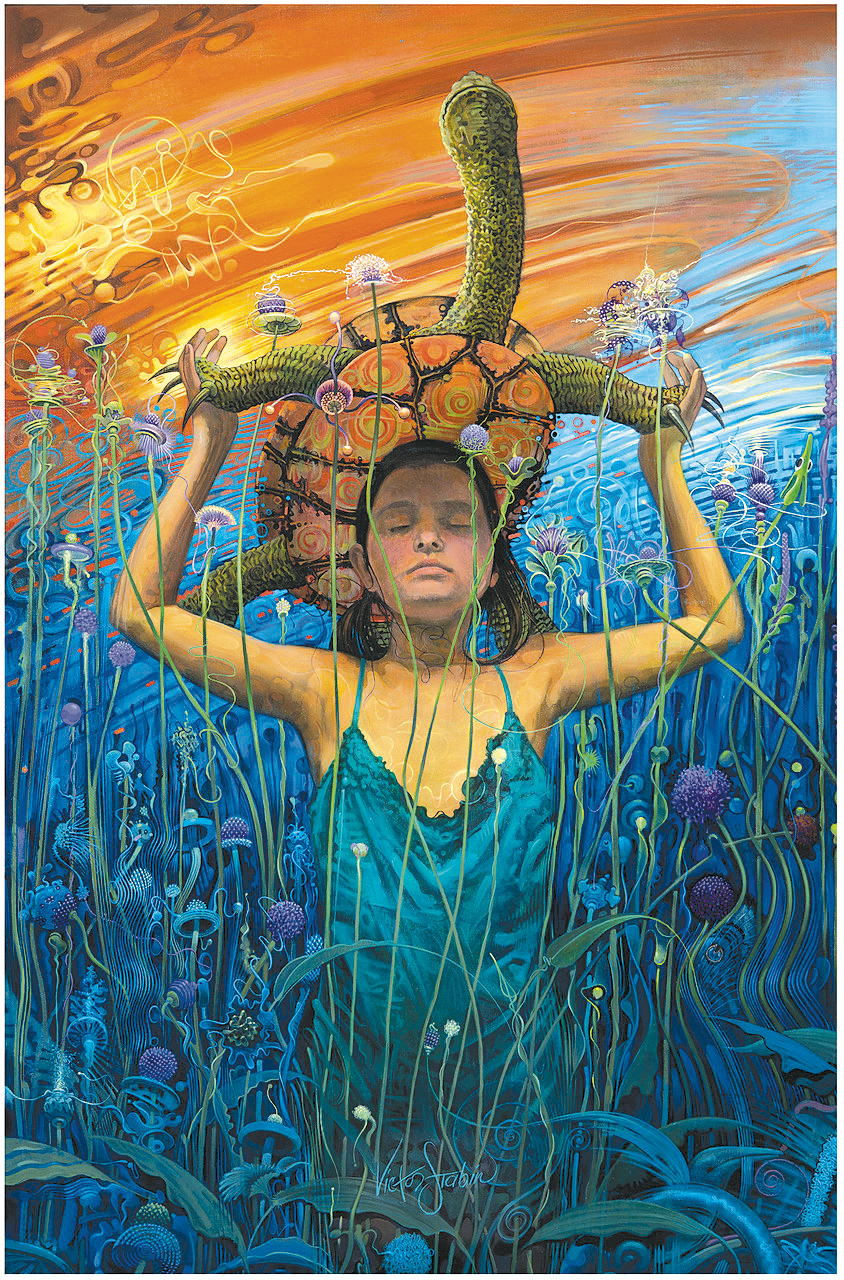


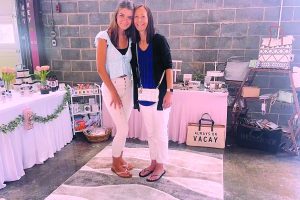
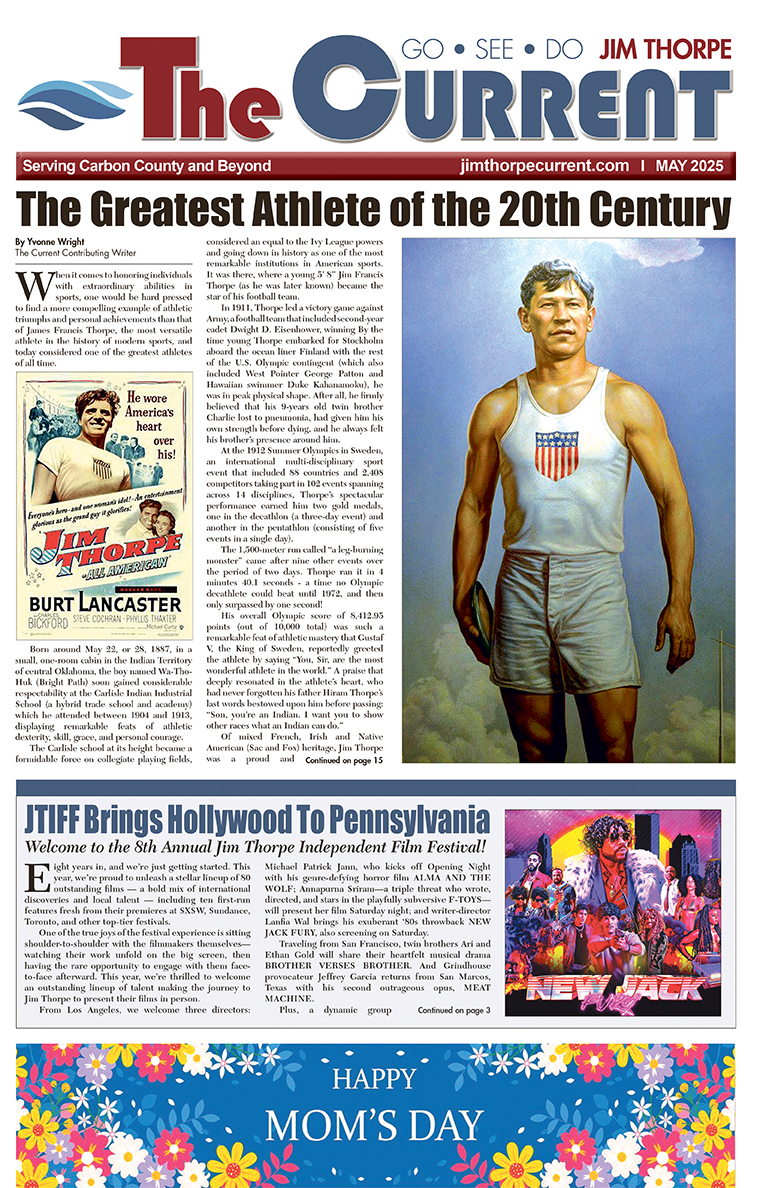














Add Comment